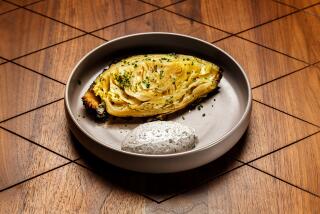Caviar for the Common Man : The Prized Delicacies Are Now Being Spawned by Trout, Salmon--Even Snails
- Share via
Caviar, once the purview of the glamorous, has entered the domain of the savvy. Exclusivity has faded as many varieties of fish eggs are now circulating in the ever-expanding gourmet food world.
Today, the Caspian Sea’s prized varieties of sturgeon roe--the premium, large-egg beluga, the medium-sized oestra and the smaller sevruga--are being challenged by caviar from locales as disparate as Chattanooga, Tenn., and the Heilongjiang Province in the northeastern part of the People’s Republic of China. What’s more, similar species, some only remotely related to the giants from the Caspian Sea, are being enlisted as sources. Per-ounce prices, too, offer something for everyone, ranging from a modest $2 to an elite $35. The less expensive and more plentiful varieties of caviar are offered primarily in their natural, colorful hues and come from the likes of trout, salmon, whitefish and lumpfish.
Demand is such that roe merchants in this country claim the existence of a black market of sorts. Smugglers routinely offer suitcases full of the distinctive blue, one-kilo tins of Iranian or Soviet fish eggs at discount prices. But according to one wholesaler, most reputable dealers shy away from such purchases, mainly because the contraband may have been mishandled or may have been stored improperly.
“There’s been a great increase in the consumption of caviar,” says Mats Engstrom, owner and founder of California Sunshine Fine Foods, Inc., in San Francisco. “People are more interested in fish and, so, we are interested in meeting that demand.”
Engstrom, along with his wife Dafne, have been pioneers in the roe business. The couple introduced Great Lakes’ whitefish eggs, under the American Golden Caviar label, in 1980 and saw sales grow from virtually nothing to more than 100,000 pounds annually.
Sales of the chunky whitefish eggs, though, pale in comparison to the Engstroms’ current project--processing sturgeon caviar from the Heilongjiang (Amur) River, which forms part of the frontier between the Soviet Union and the People’s Republic of China.
The Engstroms head a team of 15 Americans, all fluent in Mandarin, who are now processing this year’s estimated yield of 30,000 pounds of high-grade beluga and oestra, to be sold under the Tsar Nicoulai label.
The introduction of such a large volume of premium caviar has created a sensation among aficionados. Numerous tastings have placed the Engstroms’ Mandarin Beluga at parity with its Soviet and Iranian counterparts--at about two-thirds the price.
In fact, the jade-tinted eggs are a delight. When ordered directly from the firm, the roe is in excellent condition and offers a delicate, silky flavor with grasslike hints. The Mandarin Beluga is made in the malossol , or lightly salty, style and is certainly world-class.
The Engstroms’ success has spawned other entrepreneurs. For three years, Carolyn Collins, of the Carolyn Collins Caviar Co. in Crystal Lake, Ill., has been marketing trout and salmon roe, a pale-yellow egg with a more earthy flavor. (The process she uses is one she inmvented herself.) Collins is also marketing eggs from paddlefish and hackleback sturgeon. The two fish are from a subspecies of the sturgeon family found in Mississippi and surrounding states. She sells about 6,000 pounds of caviar each year at prices considerably lower than that of the imported roe.
“Today’s young consumers want what is new, trendy and preferably expensive,” she said. Demand has also been spurred, she says, by creative chefs who have incorporated caviar into all sorts of dishes.
Now all these decidedly aquatic selections are being joined by a land-based novelty: Brut d’Escargots--snails’ eggs from France.
The French product, sold under the Chatillon label, was recently introduced at elaborate tastings in New York, Chicago and Los Angeles.
The eggs are opaque; their round shape resembles that of fish roe. Because the snails are fed a diet of fennel, thyme and rosemary, they produce eggs that carry a slight herbaceousness.
A particular strain, petit gris , is used for these snails’ eggs, which at first will be available only in restaurants. The Brut d’Escargots, however, may tax the talent of even the finest chefs.
“This is a very new product,” says Dominique Bamberger, owner of La Maison du Caviar in Beverly Hills, one of the restaurants that will offer the snails’ eggs. “And it’s a good product if you know how to use it with something. But right now, people are not used to the taste.”
PRODUCED BY ROBIN TUCKER
More to Read
Eat your way across L.A.
Get our weekly Tasting Notes newsletter for reviews, news and more.
You may occasionally receive promotional content from the Los Angeles Times.










